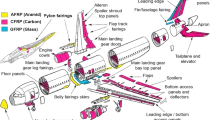Abstract
Features of chip formation can inform the mechanism of a machining process. In this paper, a series of orthogonal cutting experiments were carried out on unidirectional carbon fiber reinforced polymer (UD-CFRP) under cutting speed of 0.5 m/min. The specially designed orthogonal cutting tools and high-speed camera were used in this paper. Two main factors are found to influence the chip morphology, namely the depth of cut (DOC) and the fiber orientation (angle 𝜃), and the latter of which plays a more dominant role. Based on the investigation of chip formation, a new approach is proposed for predicting fracture toughness of the newly machined surface and the total energy consumption during CFRP orthogonal cutting is introduced as a function of the surface energy of machined surface, the energy consumed to overcome friction, and the energy for chip fracture. The results show that the proportion of energy spent on tool-chip friction is the greatest, and the proportions of energy spent on creating new surface decrease with the increasing of fiber angle.
Similar content being viewed by others
References
Chibane H, Morandeau A, Serra R, Bouchou A, Leroy R (2013) Optimal milling conditions for carbon/epoxy composite material using damage and vibration analysis. Int J Adv Manuf Technol 68(5-8):1111–1121
Silva D, Teixeira JP, Machado CM (2014) Methodology analysis for evaluation of drilling-induced damage in composites. Int J Adv Manuf Technol 71(9-12):1919–1928
Qi Z, Zhang K, Cheng H, Wang D, Meng Q (2015) Microscopic mechanism based force prediction in orthogonal cutting of unidirectional CFRP. Int J Adv Manuf Technol:1–11
Arul S, Vijayaraghavan L, Malhotra S, Krishnamurthy R (2006) The effect of vibratory drilling on hole quality in polymeric composites. Int J Mach Tools Manuf 46 (3):252–259
Davim JP, Reis P (2003) Drilling carbon fiber reinforced plastics manufactured by autoclavełexperimental and statistical study. Mater Design 24(5):315–324
Soussia AB, Mkaddem A, El Mansori M (2014) Rigorous treatment of dry cutting of FRP-Interface consumption concept: a review. Int J Mech Sci 83:1–29
Singh I, Bhatnagar N (2006) Drilling of uni-directional glass fiber reinforced plastic (UD-GFRP) composite laminates. Int J Adv Manuf Technol 27(9-10):870–876
Arul S, Vijayaraghavan L, Malhotra S, Krishnamurthy R (2006) The effect of vibratory drilling on hole quality in polymeric composites. Int J Mach Tools Manuf 46(3):252–259
Komanduri R (1997) Machining of fiber-reinforced composites. Mach Sci Technol 1(1):113–152
Koplev A, Bunsell A (1980) Machining of fiber-reinforced composites. In: 3rd International Conference of Advances in Composite Materials, pp 1597–1605
Arola D, Ramulu M, Wang D (1996) Chip formation in orthogonal trimming of graphite/epoxy composite. Compos Part A-Appl S 1(1):113–152
Nayak D, Bhatnagar N, Mahajan P (2005) Machining studies of uni-directional glass fiber reinforced plastic (UD-GFRP) composites part 1: effect of geometrical and process parameters. Mach Sci Technol 9(4):481–501
Zitoune R, Collombet F, Lachaud F, Piquet R, Pasquet P (2005) Experiment-calculation comparison of the cutting conditions representative of the long fiber composite drilling phase. Compos Sci Technol 65(3):455–466
Zhou L, Hou N, Huang S, Xu L (2014) An experimental study on formation mechanisms of edge defects in orthogonal cutting of SiCp/Al composites. Int J Adv Manuf Technol 72(9-11):1407–1414
Everstine G, Rogers T (1971) A theory of machining of fiber-reinforced materials. J Compos Mater 5 (1):94–106
Bhatnagar N, Ramakrishnan N, Naik N, Komanduri R (1995) On the machining of fiber reinforced plastic (FRP) composite laminates. Int J Mach Tools Manuf 35(5):701–716
Zhang L, Zhang H, Wang X (2001) A force prediction model for cutting unidirectional fibre-reinforced plastics. Mach Sci Technol 5(3):293–305
Jahromi AS, Bahr B (2010) An analytical method for predicting cutting forces in orthogonal machining of unidirectional composites. Compos Sci Technol 70(16):2290–2297
Ernst H, Merchant ME (1941) Chip formation, friction and finish. Cincinnati milling machine Company
Rahamathullah I, Shunmugam M (2014) Mechanistic approach for prediction of forces in micro-drilling of plain and glass reinforced epoxy sheets. Int J Adv Manuf Technol 75 (5-8):1177–1187
Atkins A (2003) Modelling metal cutting using modern ductile fracture mechanics: quantitative explanations for some longstanding problems. Int J Mech Sci 45(2):373–396
Astakhov VP, Xiao X (2008) A methodology for practical cutting force evaluation based on the energy spent in the cutting system. Mach Sci Technol 12(3):325–347
Williams J, Patel Y, Blackman B (2010) A fracture mechanics analysis of cutting and machining. Eng Fract Mech 77 (2):293–308
Wang X, Zhang L (2003) An experimental investigation into the orthogonal cutting of unidirectional fibre reinforced plastics. Int J Mach Tools Manuf 43(10):1015–1022
Rao GVG, Mahajan P, Bhatnagar N (2007) Machining of UD-GFRP composites chip formation mechanism. Compos Sci Technol 67(11):2271–2281
Ramulu M, Kim D, Choi G (2003) Frequency analysis and characterization in orthogonal cutting of glass fiber reinforced composites. Compos Part A-Appl S 34(10):949–962
Patel Y, Blackman B, Williams J (2009) Determining fracture toughness from cutting tests on polymers. Eng Fract Mech 76(18):2711–2730
Wang B, Liu Z, Yang Q (2013) Investigations of yield stress, fracture toughness, and energy distribution in high speed orthogonal cutting. Int J Mach Tools Manuf 73:1–8
Shet C, Chandra N (2002) Analysis of energy balance when using cohesive zone models to simulate fracture processes. J Eng Mater Technol 124(4):440–450
Rao GVG, Mahajan P, Bhatnagar N (2007) Micro-mechanical modeling of machining of FRP composites-Cutting force analysis. Compos Sci Technol 67(3-4):579–593
Author information
Authors and Affiliations
Corresponding author
Rights and permissions
About this article
Cite this article
Li, H., Qin, X., He, G. et al. Investigation of chip formation and fracture toughness in orthogonal cutting of UD-CFRP. Int J Adv Manuf Technol 82, 1079–1088 (2016). https://doi.org/10.1007/s00170-015-7471-x
Received:
Accepted:
Published:
Issue Date:
DOI: https://doi.org/10.1007/s00170-015-7471-x




